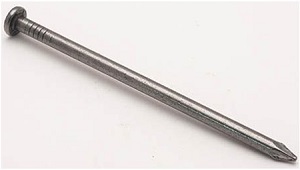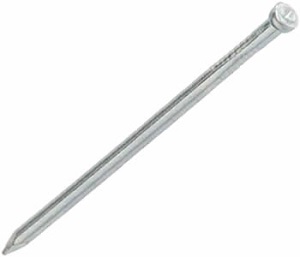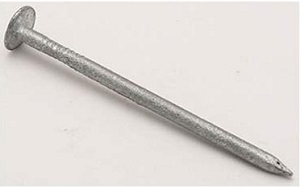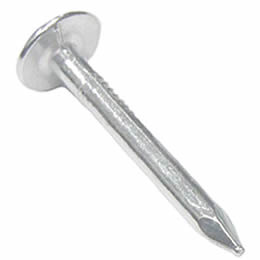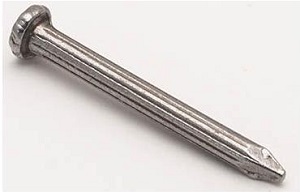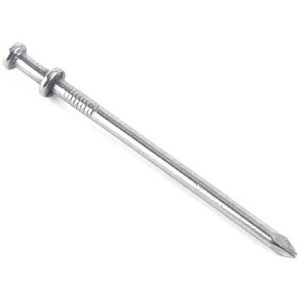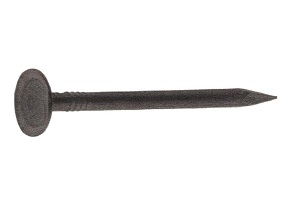Types of nails
Contents |
[edit] Introduction
Nails are a basic type of fastener and have been used in construction in some form for at least 3,000 years. They are most commonly used for joining pieces of timber or for fastening materials to timber and are suitable when a screw is unnecessary.
There are a very wide variety of nails designed for specific purposes and finishes. They are manufactured in different lengths and gauges (diameters), as required.
Nails are usually hammered into place by striking them squarely on their head. By driving the nail in this way, it is less likely to bend or break. When driving a nail into timber, it is good practice to position the nail at a slight angle to the grain of the timber so that it does not split. When timber is likely to split, or a nail is required close to an edge, it may be necessary to drill a ‘pilot hole’ which is slightly smaller than the nail diameter.
Nails must be of suitable strength, with a shank that is long enough to provide an appropriate attachment. Nails are held in place by friction, and some designs can include roughened, grooved or twisted shanks to improve the hold.
Nails are most commonly made of steel. Steel wire is fed into a machine which cuts out individual nail lengths. Wire pieces are held by grippers while a hammer flattens one projecting end to form the head. It is then cut to the specific length and point. Masonry nails are made of hardened zinc for added strength, and many nails (particularly roofing nails) are galvanized with an outer layer of zinc to prevent rusting.
When purchasing nails, it is important to note that suppliers normally sell them by weight rather than quantity. This means that a rough estimate of how many are required is sufficient and over-buying is generally recommended.
[edit] Types
While nails may vary between manufacturers, the most common types include:
[edit] Common nails
Also known as round head, these are the most widely-used type of nail for joining timber and other elements, particularly where a rougher finish is acceptable. It is good practice to use nails that are at least three times longer than the depth of the thinner material that is being nailed.
A variation is the oval head nail which is oval in cross-section and minimises the risk of splitting the timber.
[edit] Finishing nails
These are similar to common nails but have much smaller heads which sit flush with the timber surface and provide a neater finish. A nail set can be used to recess the head to conceal it completely. This capability means that they are often used in furniture and decorative or exposed timber. The smaller head sizes also mean there is a reduced risk of the timber splitting. Finishing nails can be made of brass to provide a decorative detail.
[edit] Box nails
Box nails are commonly used for light construction as they are slightly thinner than common nails and have less strength.
[edit] Roofing nails
These have larger heads and are often used for nailing shingles, attaching asphalt and other roofing purposes. The thin material is held in place and prevented from tearing loose by the large head. Smaller varieties can be used to attach roofing felt. They are typically galvanized to prevent rust.
[edit] Masonry nails
These are harder and thicker nails with small heads, typically made of hardened zinc which is stronger, enabling them to be driven into masonry surfaces effectively. They are often used to attach timber to stone or brick.
[edit] Double-headed nails
These nails are often used to secure scaffolding and other temporary structures in place. They have two heads, one above the other. They are driven in as far as the first head, while the top head remains above the surface, making it easy to remove.
[edit] Drywall nails
Drywall nails are used to hang drywall and are designed not to cut the paper face.
[edit] Annular ring shank nails
These are similar to common nails but comprise rings along the length of the shank. This provides better grip in the timber and a more secure attachment.
[edit] Special
Special types of nails include:
- Casing: For use on small mouldings or thin plywood.
- Brads: Very narrow nails that provide a neat finish. Typically used in nail guns for fast fixing.
- Glazing sprig: A wedge-shaped nail that can be used with putty to secure glazing.
- Cap nail: Includes a plastic cap and is commonly used for nailing building fabrics.
- Upholstery nail: Small, dome-headed nails that are used for attaching upholstery to furnishings.
- Carpet nail: Also known as carpet tacks, they are used to hold down carpet in awkward areas such as corners and stairs.
- Corrugated nail: Has a corrugated cross-section, often used as an 'invisible' connector.
- Staple nail: Has an arched shape for holding wire in position on structures such as fence posts.
[edit] Related articles on Designing Buildings Wiki
Featured articles and news
RTPI leader to become new CIOB Chief Executive Officer
Dr Victoria Hills MRTPI, FICE to take over after Caroline Gumble’s departure.
Social and affordable housing, a long term plan for delivery
The “Delivering a Decade of Renewal for Social and Affordable Housing” strategy sets out future path.
A change to adoptive architecture
Effects of global weather warming on architectural detailing, material choice and human interaction.
The proposed publicly owned and backed subsidiary of Homes England, to facilitate new homes.
How big is the problem and what can we do to mitigate the effects?
Overheating guidance and tools for building designers
A number of cool guides to help with the heat.
The UK's Modern Industrial Strategy: A 10 year plan
Previous consultation criticism, current key elements and general support with some persisting reservations.
Building Safety Regulator reforms
New roles, new staff and a new fast track service pave the way for a single construction regulator.
Architectural Technologist CPDs and Communications
CIAT CPD… and how you can do it!
Cooling centres and cool spaces
Managing extreme heat in cities by directing the public to places for heat stress relief and water sources.
Winter gardens: A brief history and warm variations
Extending the season with glass in different forms and terms.
Restoring Great Yarmouth's Winter Gardens
Transforming one of the least sustainable constructions imaginable.
Construction Skills Mission Board launch sector drive
Newly formed government and industry collaboration set strategy for recruiting an additional 100,000 construction workers a year.
New Architects Code comes into effect in September 2025
ARB Architects Code of Conduct and Practice available with ongoing consultation regarding guidance.
Welsh Skills Body (Medr) launches ambitious plan
The new skills body brings together funding and regulation of tertiary education and research for the devolved nation.
Paul Gandy FCIOB announced as next CIOB President
Former Tilbury Douglas CEO takes helm.
UK Infrastructure: A 10 Year Strategy. In brief with reactions
With the National Infrastructure and Service Transformation Authority (NISTA).






